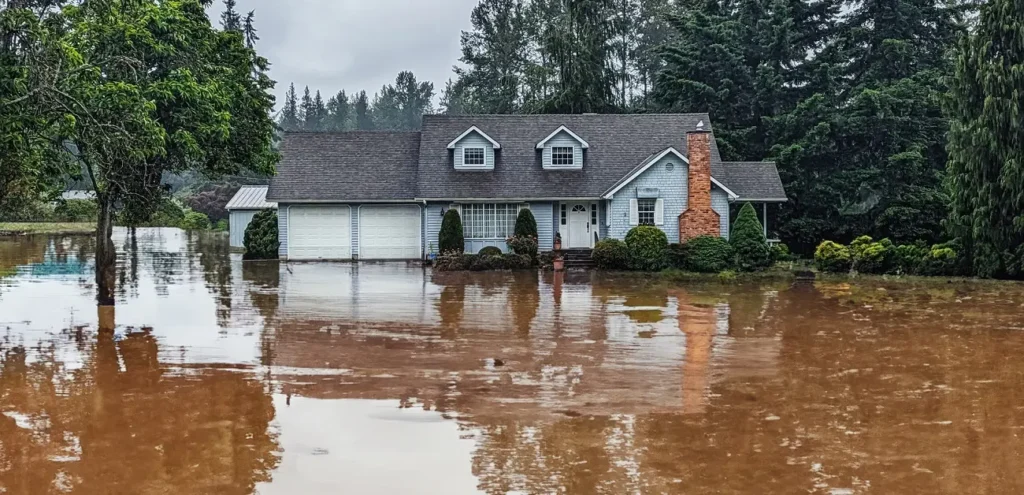Natural disasters can strike without warning, causing extensive damage to homes and properties. From hurricanes and floods to wildfires and earthquakes, the financial cost of these events can be overwhelming. Fortunately, homeowners insurance can help mitigate some of these risks, but not all policies cover every type of disaster. In this comprehensive guide, we’ll explore how homeowners insurance works for natural disasters, what coverage is typically included, and how to ensure you’re fully protected in 2024.
Understanding Homeowners Insurance and Natural Disasters
Homeowners insurance is a type of property insurance that provides financial protection in case of damage or loss to your home and its contents. Most standard policies cover a wide range of perils, including fire, theft, and certain natural disasters, but coverage can vary based on the type of disaster.
Common Types of Natural Disasters Covered by Homeowners Insurance
- Windstorms (including hurricanes and tornadoes): Most standard homeowners insurance policies include coverage for wind damage caused by storms, hurricanes, and tornadoes. However, in high-risk areas, you may need additional windstorm insurance.
- Hailstorms: Damage caused by hail is typically covered under a standard homeowners policy, although the level of coverage might vary based on your location.
- Wildfires: Fire damage, including damage from wildfires, is generally covered by standard homeowners insurance. However, in regions prone to frequent wildfires, additional coverage may be required.
Natural Disasters Typically NOT Covered by Standard Homeowners Insurance
- Flooding: Most homeowners insurance policies do not cover flood damage. If you live in an area prone to floods, you’ll need to purchase separate flood insurance, which is often provided through the National Flood Insurance Program (NFIP) or private insurers.
- Earthquakes: Earthquake damage is not included in standard policies. If you live in a seismically active area, you will need to add earthquake insurance to your coverage.
- Landslides and Mudslides: These are also typically excluded from standard coverage. If you live in an area prone to landslides, you may need to purchase specialized coverage.
- Sinkholes: While some insurance policies cover sinkholes, many do not. States like Florida, which are more prone to sinkholes, may offer optional sinkhole insurance.
Key Components of Homeowners Insurance for Natural Disasters
A homeowners insurance policy consists of several types of coverage that come into play during a natural disaster. It’s important to understand these different components to ensure you have the protection you need:
1. Dwelling Coverage
- What It Covers: Dwelling coverage pays to repair or rebuild your home if it is damaged by a covered peril (such as fire or wind). It includes the structure of your house as well as any attached structures, like garages or decks.
- Considerations: Make sure your dwelling coverage limit is sufficient to cover the cost of rebuilding your home. In areas prone to natural disasters, rebuilding costs can be higher due to demand for materials and labor following a catastrophe.
2. Personal Property Coverage
- What It Covers: Personal property coverage protects your belongings, such as furniture, electronics, and clothing, from damage or destruction caused by a covered peril.
- Considerations: Most policies set limits on how much personal property coverage you can receive. High-value items like jewelry or art may require additional coverage. You can choose between actual cash value or replacement cost coverage. Replacement cost pays to replace your items at current prices, while actual cash value takes depreciation into account, resulting in a lower payout.
3. Loss of Use (Additional Living Expenses)
- What It Covers: If your home becomes uninhabitable due to a natural disaster, loss of use coverage helps pay for additional living expenses, such as hotel stays, meals, and transportation, while your home is being repaired.
- Considerations: This coverage is particularly important for people in disaster-prone areas, as repairs can take weeks or even months.
4. Liability Coverage
- What It Covers: Liability coverage protects you if you are sued for injury or damage to someone else’s property. For example, if a natural disaster damages your property and debris from your home causes injury to a neighbor, your liability coverage would help pay for their medical expenses or property repairs.
- Considerations: Ensure your liability limits are high enough to protect your assets in the event of a lawsuit.
5. Medical Payments to Others
- What It Covers: This coverage pays for minor injuries that happen to guests on your property, regardless of fault. It’s designed for smaller claims, such as if someone is hurt by debris during a storm.
- Considerations: This coverage is usually limited to smaller amounts, often between $1,000 and $5,000.
Specialized Insurance for Natural Disasters
As mentioned, some natural disasters are not covered by standard homeowners insurance policies. Here’s what you need to know about obtaining specialized coverage for these events:
1. Flood Insurance
Flooding can cause extensive damage, and most standard homeowners policies exclude flood damage. If you live in a high-risk flood area, flood insurance is a must. Even homeowners in moderate-to-low-risk areas should consider it, as floods can occur anywhere.
- How to Get It: Flood insurance is often purchased through the National Flood Insurance Program (NFIP), though some private insurers also offer flood coverage. Policies typically cover both the structure of your home and your personal property.
- Costs: Premiums for flood insurance depend on your location, the elevation of your home, and the level of coverage you choose. Homes in high-risk flood zones will pay significantly higher premiums.
2. Earthquake Insurance
If you live in an earthquake-prone area, you’ll need to purchase earthquake insurance. Standard homeowners policies don’t cover damage from earthquakes, and even small earthquakes can cause expensive structural damage.
- How to Get It: Earthquake insurance can be purchased as an add-on (rider) to your existing homeowners policy or through a separate policy from a specialized provider.
- Coverage Details: Earthquake insurance typically covers repairs to your home, replacement of personal belongings, and living expenses if you’re displaced.
- Costs: Premiums for earthquake insurance vary by location and the level of risk. Homes in high-risk areas like California will pay higher premiums and deductibles.
3. Wildfire Insurance
While most standard policies cover fire damage, homeowners in areas prone to wildfires may face higher premiums or exclusions. In these high-risk areas, insurers may require you to purchase additional wildfire insurance to cover the cost of damage or loss.
- How to Get It: Some states offer FAIR (Fair Access to Insurance Requirements) Plans, which are insurance pools for homeowners who cannot find coverage in the regular market. In states like California, where wildfires are frequent, homeowners may need to seek coverage through these programs.
- Costs: Wildfire insurance can be expensive in high-risk areas, but it is essential for protecting your home from this increasingly common disaster.
How to Ensure Your Home Is Protected from Natural Disasters
Being prepared for natural disasters is not just about having the right insurance coverage. Here are some additional steps you can take to protect your home:
1. Assess Your Risk
Understanding the natural disaster risks in your area is the first step to making sure you have the right coverage. Use tools like FEMA’s flood map or the USGS earthquake hazard map to assess the likelihood of specific natural disasters in your location.
2. Review and Update Your Policy
It’s important to review your homeowners insurance policy annually to ensure you have adequate coverage. If you’ve made significant improvements to your home, you may need to increase your dwelling coverage. Additionally, ensure your personal property coverage accurately reflects the value of your belongings.
3. Consider Additional Riders
If you live in a high-risk area, consider adding riders to your policy for specific natural disasters that may not be covered by a standard policy. Riders can help cover the cost of repairing or rebuilding your home, replacing your belongings, and even covering living expenses while your home is being repaired.
4. Fortify Your Home
Taking steps to protect your home from potential damage can also reduce your insurance premiums. Consider installing storm shutters, reinforcing your roof, and using fire-resistant materials if you live in wildfire-prone areas. Many insurers offer discounts for homes that are built or retrofitted to withstand natural disasters.
5. Create a Home Inventory
Keeping a detailed inventory of your personal belongings can speed up the claims process after a disaster. Include photos, descriptions, and receipts if possible. Make sure your inventory is stored in a safe location, like a cloud-based service, so it is accessible even if your home is damaged.
6. Plan for the Worst
In the event of a natural disaster, having an emergency plan in place is crucial. Make sure your family knows what to do in case of a fire, flood, or earthquake. Keep important documents like your insurance policy, home inventory, and identification in a fireproof safe or digital backup.
Filing a Claim After a Natural Disaster
If your home is damaged by a natural disaster, here’s how to file a homeowners insurance claim:
- Contact Your Insurer: Notify your insurance company as soon as possible after the disaster. Many insurers offer 24/7 claim reporting services.
- Document the Damage: Take photos and videos of the damage to your home and belongings. This documentation will help speed up the claims process.
- Prevent Further Damage: If it is safe to do so, take steps to prevent further damage to your home, such as covering broken windows or tarping a damaged roof.
- Work with Your Adjuster: Your insurance company will send an adjuster to assess the damage. Be prepared to show them any documentation you’ve collected and answer questions about the damage.
- Get Repair Estimates: Once the adjuster has inspected your home, you’ll likely need to obtain estimates from contractors for repairs. Some insurance companies have preferred contractors you can work with, but you’re also free to choose your own.
Conclusion
Homeowners insurance for natural disasters is essential for protecting your home and financial security. With the increasing frequency and intensity of natural disasters, having the right coverage is more important than ever. By understanding the risks in your area, reviewing your policy regularly, and considering additional coverage options like flood or earthquake insurance, you can ensure your home is well-protected in 2024 and beyond.


